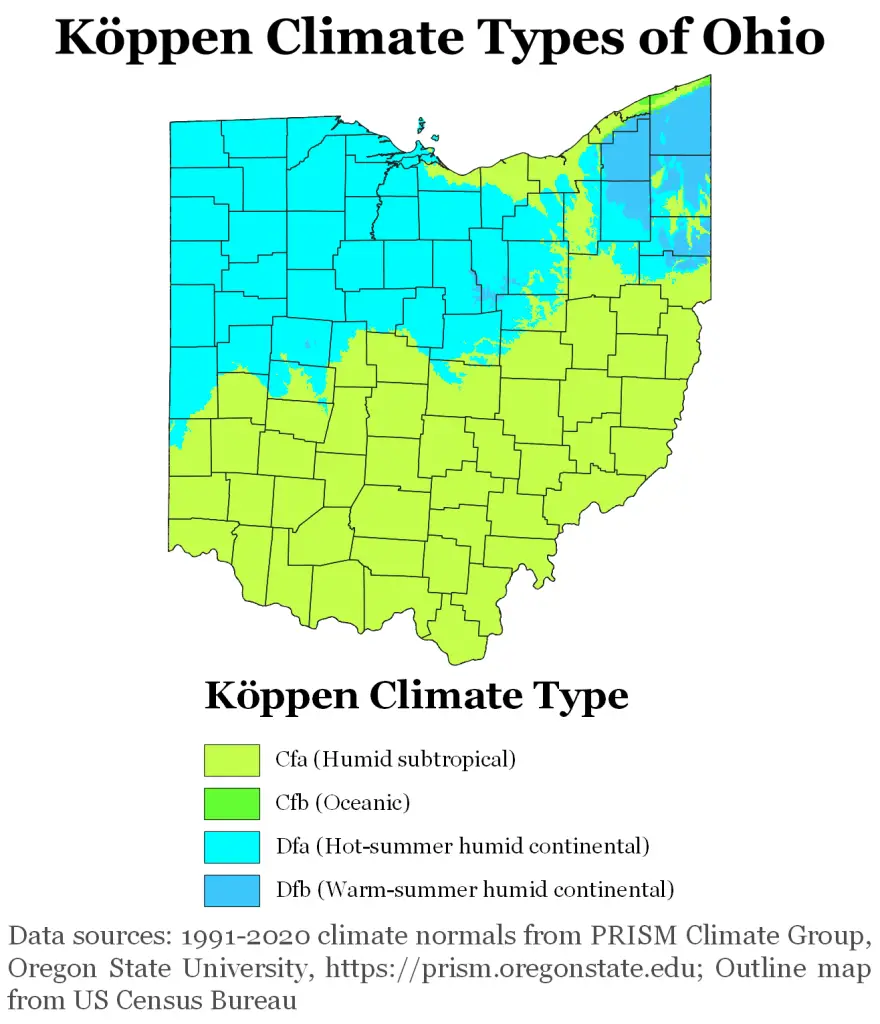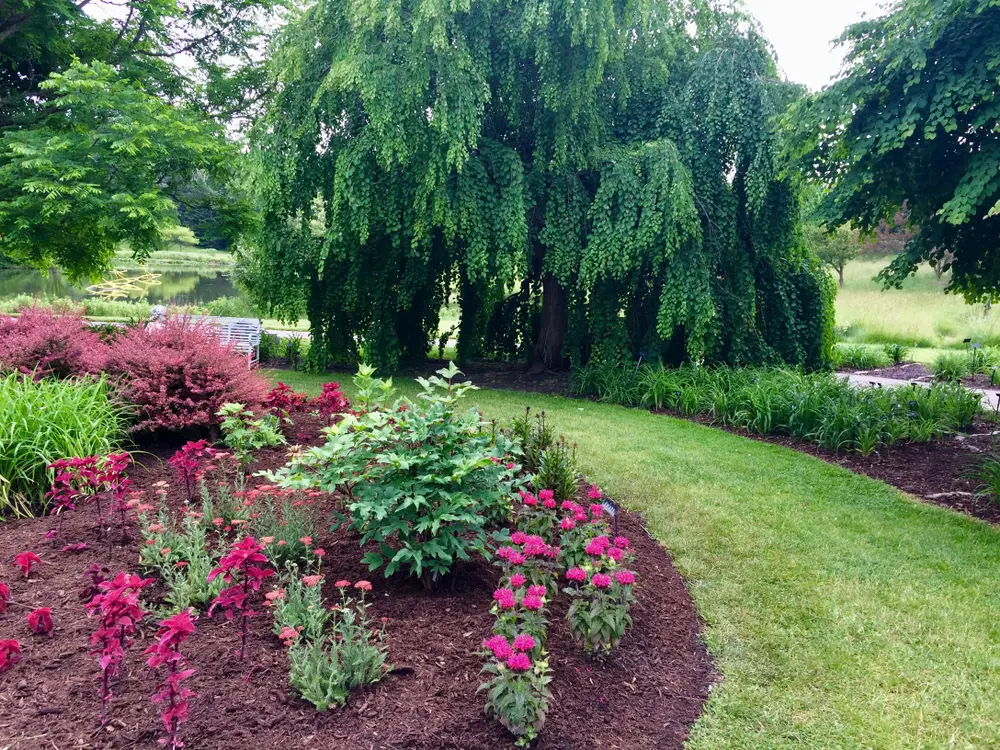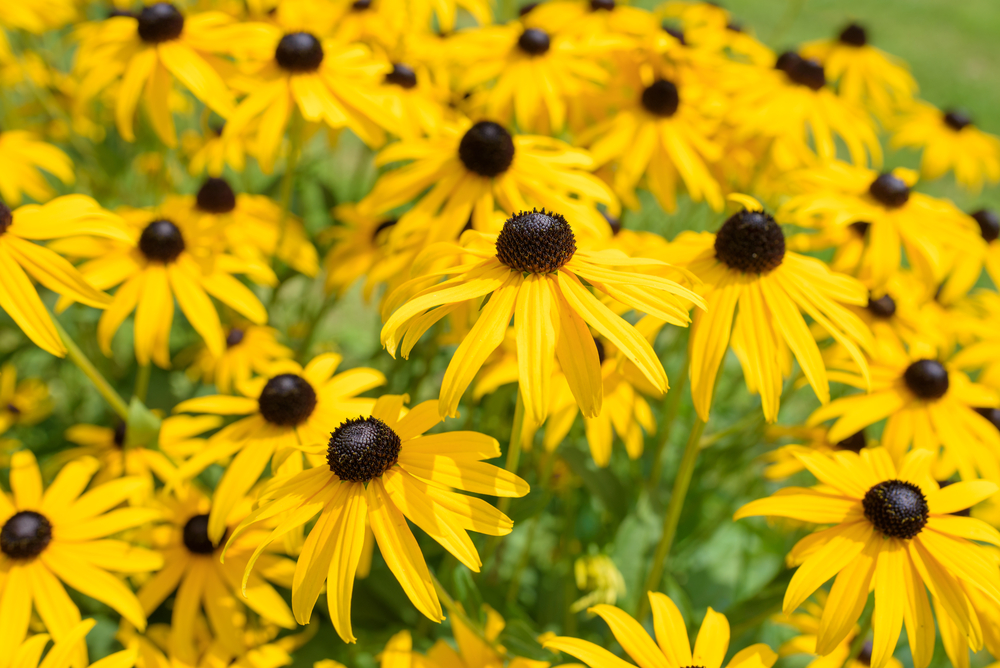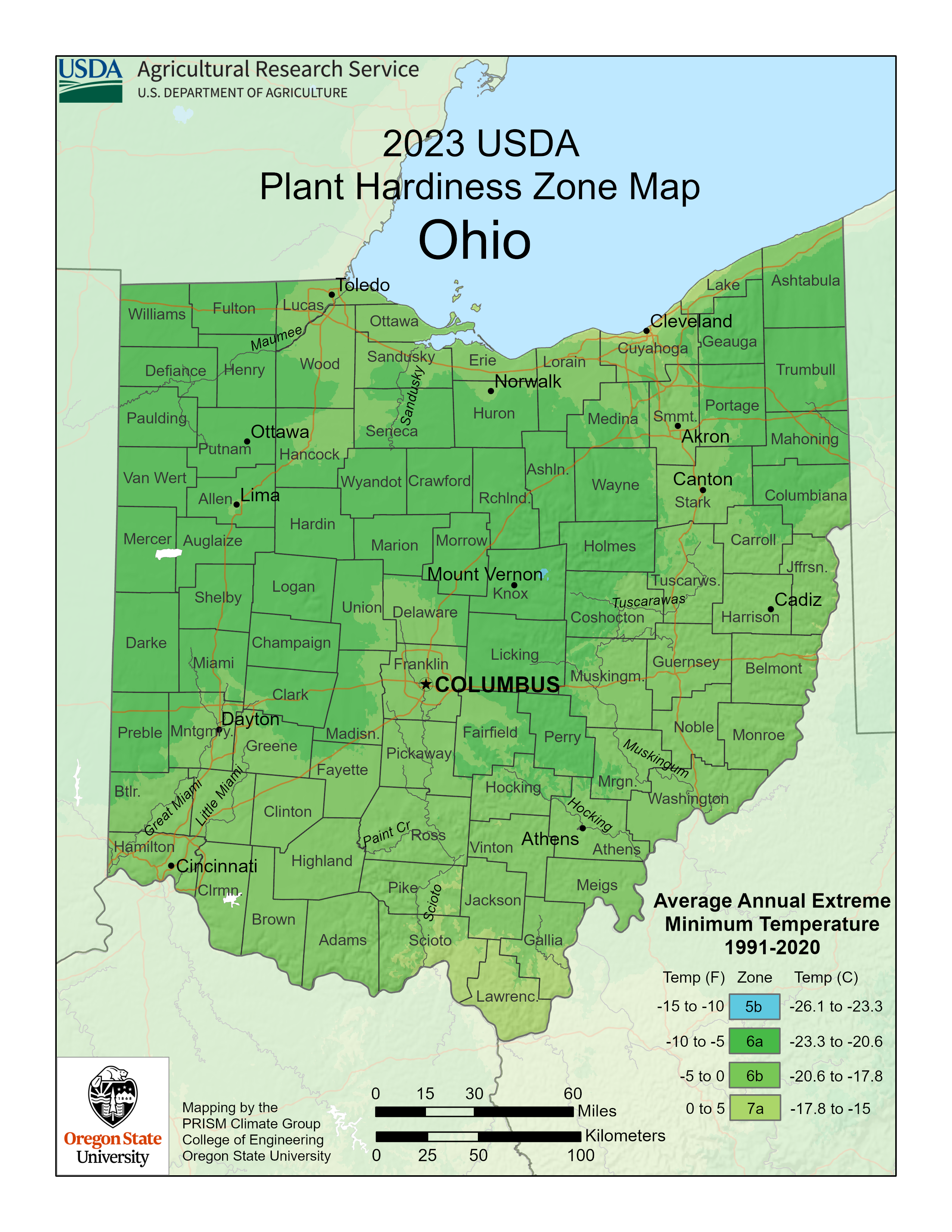Ohio Plant Hardiness Zones
| USDA Hardiness Zone | Average Minimum Extreme Winter Temperature Range Fahrenheit (°F) Celsius (°C) | Average Last Frost Date Range In Spring (Beginning Of The Growing Season) | Average First Frost Date Range In Autumn (End Of The Growing Season) |
|---|---|---|---|
| 5b | -15°F to -10°F -26.1°C to – 23.3°C | Early to mid-May | Late September to early October |
| 6a | -10°F to -5°F -23.3°C to 20.6°C | Late April to early May | Early to mid-October |
| 6b | -5°F to 0°F -20.6°C to 17.8°C | Late April to early May | Mid to late October |
| 7a | 0°F to 5°F -17.8°C to -15°C | Late April to early May | Mid to late October |
Ohio Growing Conditions
General Climate

Ohio’s climate has a wide range of weather patterns. Most of the state is temperate, including most of the southern area and a small portion bordering Lake Erie.
Temperate climates generally have a wide range of weather and fluctuating temperatures with four distinct seasons. These include warm to hot summers and cool to mild winters. The growing season in this climate is typically a bit milder than in the northern, continental part of the state, which means you can grow a wider variety of plants.
Ohio’s northern continental zone generally has a shorter growing season, with colder winters and warmer summers. This area will also experience four seasons but usually with more extreme temperatures ranging in all seasons.
Ohio generally experiences moderate precipitation consistently throughout the year.
Microclimates
USDA plant hardiness zones are an important starting point for your garden, but you’ll also need to consider microclimates.
Microclimates are areas where specific conditions create a climate different from the climate they’re situated in.
Buildings, fences, paved areas, or short hills and valleys can create these microclimates.
They can be as small as a space in your backyard or as large as a city.
In other words, learn about your local conditions from local experts to see if your garden falls into a microclimate.
Extreme Weather
Flooding
Ohio is located along the tornado belt, which means there are more extreme weather events. These can include severe thunderstorms, heavy rainfall, high winds, and even hail, all of which can result in flooding.
Flooding and waterlogging can cause lasting issues for your plants and garden, including root saturation, surface flooding, and water contamination. To ensure your garden thrives year after year, it’s important to develop mitigation techniques for these weather events. This could include specific garden designs that accommodate high fluctuations in water levels.
Tornadoes
Tornadoes are strong, violent winds that occur during severe thunderstorms. These storms can be extremely loud and have an eerie green hue that takes over the sky. They produce heavy rainfall, flash flooding, and hail. Tornadoes can be immensely destructive to your home and garden.
It’s important to watch the weather as meteorologists can predict when a storm will hit. Tornado season in Ohio typically occurs from mid-spring until mid-summer, when conditions lead to shifting weather patterns and drastic temperature changes.
Planning for extreme weather events such as tornadoes helps ensure that your garden survives season after season. For example, you could focus on native plants with strong root systems to combat high winds.
Extreme Cold
Ohio can experience extreme cold during the winter (particularly in the northern part of the state). This is a time for hibernation and rest in the garden, and you’ll typically have already cleaned up in the fall.
The extreme cold can do damage to a garden if you select incorrect plants for this climate. Picking the right plants for your hardiness zone ensures their success. Winter prep can also help to mitigate winter die-off. Winter die-off occurs when extreme cold kills plants. Focusing on native plants can help avoid this as they are acclimated to the weather in Ohio.
Growing Season
Ohio’s growing season is generally short to mid-length, extending from late April to mid-October (depending on your zone and region).
Using a cold frame or greenhouse can extend the length of your growing season. Due to the severe weather in the spring, it would be advantageous to focus on late summer-fall-blooming plants.
Ohio Gardening Tips

Choose The Right Plants
Plant selection in Ohio is one of the best ways to mitigate damage during tornado season, although it also may just come down to sheer luck. Choosing plants with strong root systems helps keep them intact during heavy winds and flash flooding. Native plants are more resistant to the drastic weather changes in their particular hardiness zone and are, therefore, more likely to survive the extremes in their range.
Follow Proper Garden Design
Proper garden design can work wonders in areas with lots of flooding. Check out rain garden designs, where you dig trenches beneath or around your garden and fit them with piping and drainage rocks to help with the dissipation and directional flow of the water.
Raised garden boxes elevate your plants and increase drainage as well. This gardening method works best for annual veggies and more delicate plants as they are more sensitive to extreme weather conditions.
Additionally, putting your favorite plants in movable containers and bringing them inside during the severe weather is a good way to keep them alive.
Do Winter Garden Prep
With the right plant selection, you can manage extreme winters. Native plants are acclimated to Ohio weather systems and, therefore, can tolerate colder winters. Another way to help your plants manage the cold is to mulch your garden beds with leaf mulch. This keeps your plants’ roots warm and cozy under a layer of snow. You can also wrap mid-sized shrubs in burlap to create another barrier against the wind and cold.
Embrace A Zen-Like Detachment
Living in a state where tornadoes happen every spring, it’s important to know that as the seasons change, so will your garden. Try to remove any attachment to the garden and look at it as a growing experience!
The thought of losing plants and a garden that you worked so hard on can seem frustrating, but having this knowledge ahead of time can help you plan accordingly.
This might mean growing plants from seed as it is a more economical approach. Another option would be to start with a smaller garden and, as the seasons progress, see what does well and what doesn’t. This way, you can continue to build with resilient plants, creating a stronger, more durable garden.
If you have plants you love, keep them in pots and bring them inside during the more turbulent seasons. Although impermanence can be a hard notion to accept, it is a part of growing a garden and a wonderful lesson on life.
Stay strong, and keep planting!
Consult With Local Professionals
Consulting with local gardening professionals allows you to benefit from their experience with your area’s conditions, the plants that do well there, and overall best practices.
Ohio Plant Suggestions

Trees
- Flowering dogwood (Cornus florida)
- Eastern Redcedar (Juniperus virginiana)
- American beech (Fagus grandifolia)
Shrubs
- Rosebay rhododendron (R. maximum)
- Bottlebrush buckeye (Aesculus parviflora)
- Buttonbush (Cephalanthus occidentalis)
Flowers
- Black-eyed Susan (Rudbeckia hirta)
- Smooth Blue Aster (Symphyotrichum laeve)
- Rose Milkweed (Asclepias incarnata)
Vegetables
- Buttercrunch lettuce (Lactuca sativa var. capitata)
- Sugar snaps peas (Pisum sativum var. macrocarpon ser.)
- Winterbor Kale (rassica oleracea var. acephala)
Herbs
- Greek Oregano (Origanum vulgare)
- Lemon Thyme (Thymus citriodorus)
- Apple Mint (Mentha suaveolens)
Spices
- Garlic (Allium sativum)
- Spicebush (lindera benzoin)
- Ginger (Zingiber officinale)
Fruits
- Gala Apple (Malus domestica)
- Highbush Blueberry (V. corymbosum)
- Smooth Blackberry (R. canadensis)
Succulents
- Wild stonecrop (Sedum ternatum)
- Hens & Chicks (Sempervivum tectorum)
- Prickly Pear Cactus (Opuntia humifusa)
Disclaimer
Any of the above can change and is not exhaustive.
Treat anything above like a good starter guide. Then use that as a foundation as you consult with local gardeners, professionals, forecasts, guides, and organizations.

